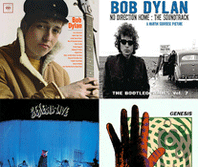Most artists and bands have a point in their career where their sound and style evolves (or in some cases, devolves) beyond what they were known for. This can be brought about by boredom, the need to put food on the table, pressure from a label, the desire for mainstream success, or in some cases, an attempt at career suicide (Metal Machine Music, anyone?)
Sometimes these transformations work, and other times they don’t. What follows are five bands and artists that radically changed their style at some point in their career, and were rewarded in big ways.
Bob Dylan
Masters Of War (1963) / Maggie’s Farm (1965 Newport version)
Few artists have transformed their sound with such polarizing effect as Bob Dylan. Initially finding success as an acoustic guitar / harmonica wielding “folkie,” Dylan shocked his core fanbase at the Newport Folk Festival in 1965 by introducing electric instruments into the mix.
Mike Bloomfield’s wailing lead guitar must have sounded like nails screeching down a chalkboard to the audience, and the thunderous round of boos were the proof. Dylan may have lost Pete Segar as a fan that night, but as we all know this new sound worked out just fine for one Mr. Zimmerman.
Genesis
The Return Of The Giant Hogweed (Live – 1973) / Invisible Touch (1986)
Fronted by one of the most “out there” (and talented) lead vocalists of all time, Peter Gabriel, Genesis started out as one of the premier progressive/art rock band of the 1970’s. Alongside contemporaries including King Crimson, Yes and ELP, they pushed the boundaries of Rock, taking it to places it had never been before.
Following Gabriel’s departure in the mid 1970’s, the band’s drummer, Phil Collins, took over frontman duties. Each subsequent album became more and more commercial, and by the time of 1986’s Invisible Touch, barely a trace of their Progressive/Art Rock beginnings could be found.
Aerosmith
Round And Round (1976) / I Don’t Want To Miss A Thing (1998)
Back in the 1970’s, Aerosmith was a lean, mean, raw, down and dirty Hard Rock/Blues band with a Metal edge. By the 1990’s, collaborators such as Dianne Warren had shifted the bands’ sound in a much lighter, poppier mainstream direction, which bore little resemblance to their beginnings.
Jefferson Airplane/Starship
3/5 Of A Mile In 10 Seconds (Live 1969) / We Built This City (1985)
Alongside bands such as the Grateful Dead and Quicksilver Messenger Service, Jefferson Airplane was at the forefront of the Haight Asbury hippy scene during the mid to late 1960’s. Their sound possessed a Hard Rock/Psychedelic nature, thanks to the eclectic combination of Kaukonen/Cassidy, Slick/Kantner, and Marty Balin.
By the time the mid 1980’s rolled around, the band’s sound and name were radically different. Now known as Starship, Grace Slick was the sole remnant from the original band. Their sound bore no resemblance to the Airplane, characterized by lightweight mainstream Pop/Rock.
Taylor Swift
Mean (2010) / Shake It Off (2014)
Taylor Swift’s career began as a Country artist/writer with Pop leanings, which brought her massive success. Instead of sticking to the “formula,” she started to enlist A-list Pop collaborators such as Max Martin and Shellback on her 2012 album Red, which started to push her more in a mainstream Pop direction in lieu of her Country roots.
By the time 2014’s Shake It Off rolled around, all hints of Country were gone, and the transformation into mainstream Pop superstar was complete.



